ColecoVision:
ALIVE WITH FIVE
By Owen Linzmayer
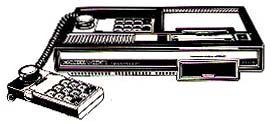
|
Software support for the recently introduced ColecoVision home video system is coming on strong. In an effort to attract consumers, Coleco has already released five arcade game cartridges: Donkey Kong, Cosmic Avenger, Venture, LadyBug, and Smurf Rescue. Although their appeal is varied, all of the games have one thing in common:
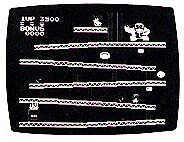
|
Donkey Kong
Each ColecoVision system comes with a free Donkey Kong cartridge. It was not by accident that Coleco decided to include this particular game. What better way to entice a buyer than to throw in the number one coin-op game? Coleco did a fabulous job with their first release. Donkey Kong is definitely the most impressive of the first five cartridges, and it's free.
Any reader not familiar with Donkey Kong has probably spent the last year locked in a closet with Rubik's Cube. For you dyed-in-the-wool puzzlers, let me set the stage. In Donkey Kong, the player assumes the guise of Mario (the Jumpman), whose beautiful girlfriend has been kidnapped by the evil ape, Kong. Mario, heroic guy that he is, must save the girl---or die trying.
There are four separate playscreens in Nintendo's coin-op version of Donkey Kong; the ColecoVision adaptation has only three.
After inserting the ROM (read only memory) cartridge into the ColecoVision, you have a choice of difficulty levels. There are four levels, but the distinctions during game play are subtle. As with all of the Coleco games, you must also select either a one or two player game. Unfortunately, players cannot pick independent difficulty levels.
Once the options have been chosen, you advance to the game itself. The first scene is composed of five ramps connected by ladders. Mario appears at the bottom of the screen and must reach the girl who is being held captive at the top of the board. This board is fairly easy; Mario must avoid only the barrels that Kong is throwing down at him.
Rather than jumping the barrels, Mario can use a hammer to smash them. Once he has grabbed a hammer, Mario starts swinging. Due to a programming oversight, instead of hitting the hammer, a barrel must touch Mario's body before it is destroyed. The hammer disappears after 13 seconds of use, but there is nothing that warns the player when this is about to happen.
While the Jumpman is running around on the ramps, a timer in the upper left-hand corner of the screen slowly ticks down. If this timer reaches zero, you lose a man. If at any time during play you lose a man, you must start the screen over; from the very beginning. When you complete a screen, the bonus remaining on the timer is added to your score and you advance to the next board.
The second board is commonly known as the "rivets" screen. You must remove six rivets by walking over them. When all six rivets are gone, the screen is completed. Extra points are awarded if Mario picks up the accessories that Kong has scattered on the girders.
The obstacles on this screen include menacing firefoxes, balls of flame that are deadly to the touch. Luckily, the firefoxes are incredibly stupid. Completing this screen should be relatively easy. One thing that is missing in the ColecoVision version of Donkey Kong is a short intermission between screens.
The third screen is very difficult to complete. While avoiding firefoxes, you must jump around a series of platforms, elevators, and ladders. The springese (mashers) from the coin-op Donkey Kong have been replaced with firefoxes on the right hand side of the screen.
This board provides the greatest amount of flexibility in movement and patterns. Once you become skilled enough to finish this board, it becomes a huge playground--providing an excellent place for you to show off your talents. After completing this screen, the program again cycles through the three screens and the game becomes progressively more difficult.
Coleco's Donkey Kong is the most faithful adaptation of the original video game I have seen on any home system. From the "cutesie" graphics, right down to the jovial sound effects, Donkey Kong is a winner. The freedom of movement and limitless variety allow each game of Donkey Kong to be new and exciting.
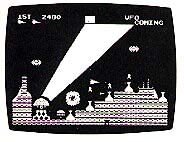
|
Cosmic Avenger
After the success of Stem's Scramble, a flurry of games based on a similar theme arose. One of the better games to surface was Cosmic Avenger from Universal. Although not very popular in the coin-op halls, Cosmic Avenger looks promising in its home version.
The object of Cosmic Avenger is to fly your fighter over enemy terrain and destroy as much as possible. The landscape below you scrolls from right to left. As an object passes by, you can either shoot it or drop a bomb on it. Meanwhile, you must avoid the missiles that the enemy is firing at your jet. There are three landscapes: city, open field, and underwater. Each landscape contains its own special form of attack, and your strategies had better change accordingly if you plan to survive.
There is a radar scope in the top center of the screen to help you spot hostile saucers. Saucers are especially threatening because they move randomly as they fire bullets at you. Without the saucers, the lower difficulty levels would present no problems whatsoever. Unfortunately, the higher levels become very difficult--sometimes three saucers attack simultaneously.
I personally like to play a good "death and destruction" game every so often. Cosmic Avenger satisfies my craving to see enemy forces laid waste on my television screen. The explosions are primitive, but the graphics overall are detailed and realistic. Considering the amount of video that must be moved, the scrolling of the terrain is quite smooth. One thing I have noticed is that when there are quite a few moving objects on the screen, some will flicker on and off. This is distracting and makes the game more difficult. Rather than sacrifice game playability, the designers at Coleco must have decided to live with the occasional flickering.
The three different landscapes provide variety with an ever-changing video background. The only thing I don't like about Cosmic Avenger is that the transition between the above-ground terrain and the underwater landscape is unrealistic. One moment you are flying over a field and suddenly the mouth of an underwater cavern appears out of the sky.
Although Cosmic Avenger was not terribly popular in the arcades, I think Coleco's adaptation will do well in the home market. Cosmic Avenger is a nice addition to the rapidly expanding ColecoVision software library.
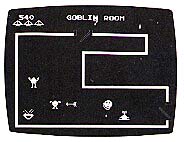
|
Venture
When Exidy released their new arcade game, Venture, in July of 1981, they hoped to cash in on the fantasy role playing market. Venture was the first video game that catered to the special interests of dungeon dwellers across the country. The player had one object: infiltrate an underground maze complex and steal as much treasure as possible.
With the Venture cartridge, ColecoVision owners can now participate in plunderous campaigns without ever leaving their armchairs.
There are four difficulty levels to choose from, so everyone from wimp to warrior should be able to find an appropriate one. After selecting a level, you are placed on the first floor. There are three floors in all, each with four rooms. To delve down to the next floor, you must snatch all of the treasures on the present floor.
A floor is made up of hallways and four irregularly shaped rooms. When your character, Winky, is in a hallway, the screen is filled with a large overhead view of the entire floor. You are represented by a little red dot and the green things running after you are called Hallmonsters. The object is to enter a room while avoiding contact with the Hallmonsters. When you go through a door, an overhead view of that room fills the screen.
Each room, with the exception of one, is inhabited by at least three monsters. If you are skilled enough, you can kill these monsters with your bow and arrows. Using the joystick and the left firing button allows you to move or shoot in eight directions.
If a monster is shot, it starts to decay. Touching a decomposing monster is every bit as fatal as running into a live one. To grab a treasure in a room, simply pass Winky over it. The treasure will blink and your exit will be accompanied by the William Tell Overture.
The biggest complaint I have about Venture is that there are only 12 rooms. After you loot the first three floors, the computer cycles through them again and again. If you manage to survive three cycles, the computer simply keeps you on the third floor. With the exception of this fault, ColecoVision Venture is just as enjoyable as the arcade version. Nothing from the original is missing, except the coin slot.
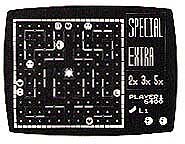
|
LadyBug
LadyBug is the second arcade game licensed to Coleco by Universal. After a cursory glance at the game, many people cry out " Oh no, not another Pac-Man. " But LadyBug is not one of the many PacMan rip-offs. If you take the time to watch a game of LadyBug in action, you soon realize that there are player-movable turnstiles that set it apart from all other maze games.
The general description of LadyBug sounds very similar to Pac-Man: you are trapped in a maze that is littered with dots that you must eat without getting caught by the monsters. LadyBug differs from Pac-Man in that there are turnstiles, hearts, letters, and skulls lying around in the hallways.
Only the LadyBug can swing a turnstile 90 degrees; this gives her a big advantage in escaping the jaws of the rampaging insects. Running into a skull proves deadly for player and monsters alike. Eating the hearts and letters takes concentration and coordination if maximum scores are desired.
As the game is played, two independent timers are running. The first timer is the green and white border that outlines the screen. Each time this completes a cycle around the perimeter of the board, another insect is released into the maze. The second timer is not visible. It controls the interval at which the hearts and letters change color.
These objects cycle through red, yellow, and blue. If a heart is eaten while it is blue, the base point multiplier advances. If you eat a letter when it is either red or yellow, that letter lights up in the word Special or Extra respectively. This takes a while to get used to, but soon you can rack up a tremendous number of points by taking full advantage of these scoring opportunities.
There are some differences between the original and the Coleco adaptation of LadyBug. In the ColecoVision version, instead of winning a free game for lighting up all of the letters in the word Special, you are awarded a romp through a vegetable garden. If successfully harvested, the vegetable garden can cause your score to double, even triple.
Another major difference is the difficulty levels. While playing the Coleco version, the insects become incredibly fast on the ninth board. The coin-op game progresses at a slightly slower rate. There is not that much difference in the four selectable difficulty levels in LadyBug. This lack of difficulty control means that LadyBug may be a little too hard for young children.
We at Creative Computing have the pleasure of having a full-sized coin-op LadyBug machine right outside the company lunchroom. Quite a few lunchbreaks have been extended for "just one more game. " When the LadyBug cartridge arrived, I ran to our ColecoVision console and plugged it in. Within minutes word had spread and the line that had been waiting outside the lunchroom was anxiously peering over my shoulder. Ever since we got our copy of Coleco LadyBug, the coin-op version seldom gets a workout. Coleco's version is just as much fun as the original and it doesn't run on quarters.
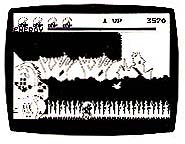
|
Smurf Rescue
Pac-Man was the first to make the transition from video games to Saturday morning cartoons. Hoping that this can be done in reverse order, Coleco has introduced Smurf Rescue. The little blue hobbit-like creatures who invaded the country last year now have their very own arcade game.
Gargamel has kidnapped the one and only Smurfette. It is up to the Smurf player to risk life and limb in an attempt to rescue the defenseless Smurfette from the clutches of the evil Gargamel.
I must admit, I was a little bit cynical when I heard that Coleco was going to introduce this cartridge. I was sure they were just milking the Smurf theme for all it was worth. Not so. Upon playing the game I found it was truly good fun!
Your Smurf starts off at his little home and must travel far off into the distance at the right if he hopes to see Smurfette alive again. There are five terrains that you walk through: a forest, open fields, an underground cavern, the castle, and finally, the room where Smurfette is held. Dangers include fences, bluffs, sharp blades of grass, stalagmites, hawks, bats, and spiders. Your Smurf can run, jump, or duck to avoid these dangerous things.
The graphics in Smurf Rescue are hi-res and detailed. The walking action of the Smurf looks very realistic. One thing we found humorous is that your Smurf never changes his facial expression; no matter what is happening, he continues to walk around with that "I-don't-care" smile of his.
When Smurf reaches the rightmost side of the screen, the entire scene shifts over to the left and a new scene appears. Since each new screen is selected at random, a player can go back and forth between two screens until he encounters one to his liking.
The difficulty level you choose determines the distance you must travel and the number of Smurfs you have in reserve. Running into any of the obstacles causes you to lose a Smurf. You can also lose a life if you run out of energy. Energy is exhausted as time goes by and as Smurf engages in jumping activities. Each time you enter a different terrain, your energy is restored to full strength.
In the final scene, Smurf must hop onto a skull from which he jumps to save Smurfette. Once done, he receives 10,000 points and starts another mission from the beginning. Unfortunately, after Smurfette is rescued, the game does not increase in difficulty.
With its range of difficulty levels, Smurf Rescue presents a challenge to very young children as well as to the older crowd. I took the ColecoVision home once to see what the neighborhood kids thought of it; they loved it. I almost had to evict them from my house at night so I could get a game in before going to sleep. Smurf Rescue is bound to be a favorite among the youngsters in your house; it's so cute.
I am very impressed with these five ColecoVision cartridges and can only hope that succeeding releases are of the same high quality. Coleco has done one heck of a job with software support. Each cartridge is backed by a limited 90-day warranty and a toll-free service hotline. Take heart video masters, there is finally a company that takes us as seriously as we take our games.